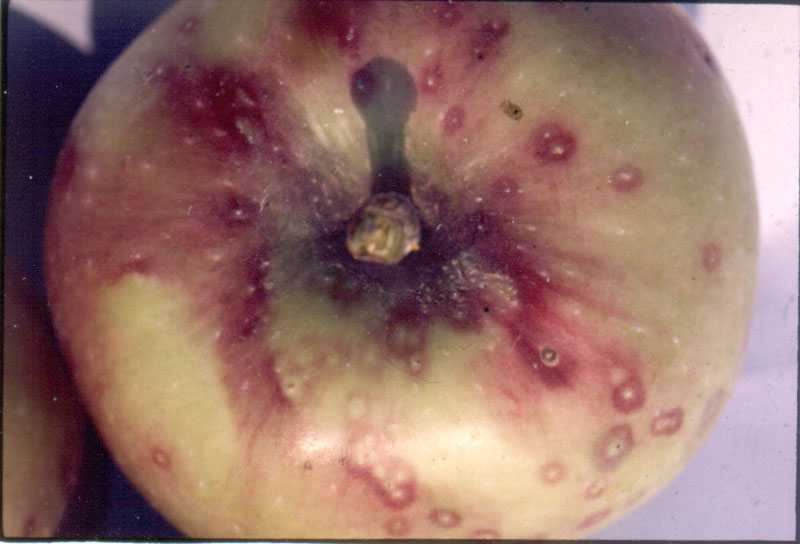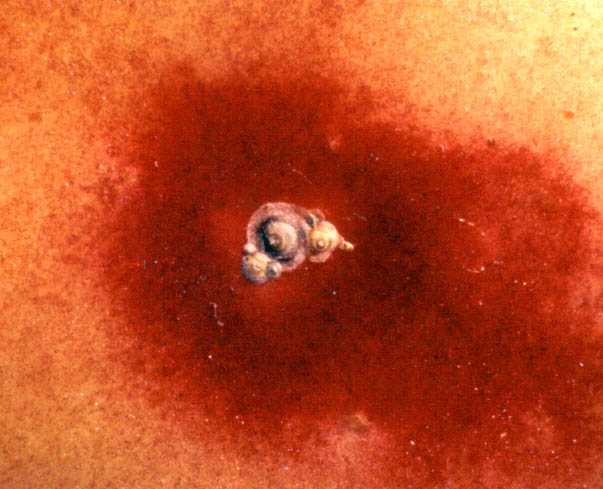San Jose Scale
General Description
Hosts
All tree fruits, many ornamental trees and shrubs.
Damage
Bark - Dead areas in inner bark; twigs and branches girdled.
Leaves - Small, brown dead spots in summer.
Fruit - Red spots and deformed tissue surrounding scale (Fig. 1).
 |
| Figure 1. San Jose scale damage to apple. (BCMA) |
Identification
Crawler - Less than 0.5 mm long, yellowish, flattened, wingless, with legs and antennae (Fig. 2).
 |
| Figure 2. San Jose scale crawlers. (AA-FC) |
Whitecap - Shell white and loose, like cotton.
Blackcap - This stage resembles a hard, gray to black, cone-shaped to oblong shell on smooth bark of twigs and small limbs, leaves or fruit, size variable (Fig. 3).
 |
| Figure 3. San Jose scale. (AA-FC) |
Peak of shell is central and ringed by one or two grooves. Central area of underside of shell coloured black or gray to yellow. The shell covers a bright yellow immobile insect. Inner bark on branch under the scale is coloured red to purple. A red spot forms around the scale on fruit.
Adult male - 1.5 mm long, yellowish with a dark band on back and two transparent wings.
Life History
San Jose scale overwinters in the immature blackcap stage on bark in tops of trees. Adults mature in spring and winged males emerge at full bloom to petal-fall of apples. Males fly or walk to reach pheromone-emitting females. The immobile females produce living young called crawlers. Crawlers move to new feeding sites on fruit or bark, insert their sucking mouthparts to feed, secrete wax to form a shell and then lose their eyes, legs and antennae. There are two to three generations per year.
Monitoring
A pheromone trap is available to attract adult males, but may indicate a later emergence than actually occurs because in cold, windy spring weather males walk rather than fly to reach the females. Wrap double-sided sticky tape around infested branches to detect first emergence of males or crawlers. Inspection of fruit at harvest or in the packinghouse will indicate whether a problem exists.
Management
Biological Control
Native predators and parasites are not adequate to prevent fruit infestation.
Cultural Control
During harvest mark areas where many scale are present. Prune out heavily infested branches and long pruning stubs that interfere with spray coverage. Consider removing large old trees encrusted with scale.
Chemical Control
Infested blocks need one or more annual sprays to protect the fruit. A single well-applied spray at tight cluster will give adequate protection in orchards where there is no encrusted scale. Blocks with large trees having encrusted scale under rough bark require careful attention to spray coverage and additional post-bloom sprays.
Spray coverage - Thorough spray coverage of the trees is extremely important in controlling scale. Because the scale caps lodge underneath rough bark, the spray material must run down behind loose bark to reach them. Effective control requires at least 2200 L/ha of dormant or summer spray mixture. On large old trees with encrusted scale under rough bark, an even higher volume of spray material is required. Apply the extra volume by handgun to ensure all limbs with rough bark are thoroughly drenched. Alternatively, the trees may be sprayed from four sides with an airblast sprayer using a total of 4500 L/ha of spray mixture. When spraying trees from four sides, use the same travel speed and the same nozzle arrangement as when spraying from two sides, but put half the amount of chemical in the tank. Apply the same amount of chemical per hectare with twice the amount of water. For satisfactory control with airblast machines, spray at low speed and only under absolute calm. Keep trees as low as possible and remove long pruning stubs that interfere with spray distribution. Remove props from trees before spraying.
Recommended spray timings and products:
- Dormant to tight cluster - dormant oil (will also help control aphids, European red mite and European fruit scale).
- Summer - Apply Closer, Movento or TwinGuard when crawlers are active. A surfactant (eg. Agral 90) is required for Movento.
For best control of scale insect problems use high volume sprays with recommended products to ensure thorough and uniform coverage of tree surfaces, including the trunks.
